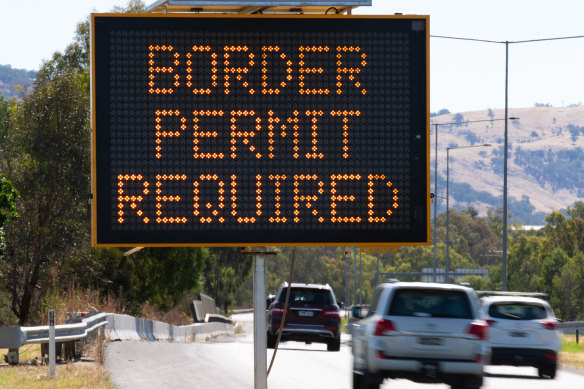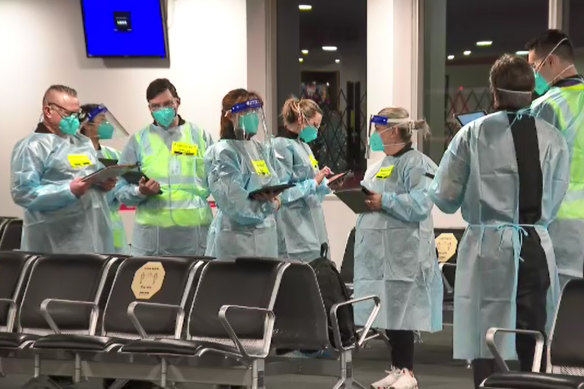This was published 4 years ago
What does Sydney’s lockdown mean for Victorians
Sections of Sydney are set to go into lockdown from Friday night and other states are introducing travel restrictions on anyone who has passed through NSW “red zones”, even as other states relax border rules for travelling Victorians.
With school holidays beginning on Friday for most Victorian schools, many residents are concerned about how the rapidly changing border situation might affect their travel plans.
Keep reading for a detailed outline of the rules in place for Victorian residents seeking to return from NSW and a state-by-state rundown of the latest restrictions for people who have been in Victoria and want to travel interstate.
This story will be updated as we get new information, so please check back to ensure you have the most up to date information.

Border closures and travel restrictions in response to Sydney's coronavirus outbreak have caused headaches for travellers.Credit: John Russell
NSW
Greater Sydney and Wollongong have been classified as red zones by Victorian authorities as of 1am on Friday.
Within Greater Sydney, the local government areas of Waverley, Woollahra, Bayside, Canada Bay, Inner West, Randwick and the City of Sydney were made red zones effective as of 1am June 23.
The classification means non-residents of Victoria who have visited those areas will be barred from entering the state unless they qualify for an exemption.
Victorian residents can apply for permits to return home, but will have to self-quarantine for 14 days from arrival. They are also required to get a COVID-19 test within 72 hours of entering Victoria and then return a negative day-13 result before exiting isolation.
However, Victorian residents won’t be eligible for a permit if they’ve been to a very high-risk exposure site in a red zone in the past 14 days, are a close contact of someone with COVID-19, or have been diagnosed with the virus.
Victorian authorities also retrospectively declared all areas in Greater Sydney, including Central Coast, Shellharbour, Blue Mountains and Wollongong, orange zones for the period between June 11 and when they become a red zone.
This means that anyone who spent time in those areas from June 11 to June 24 will need to isolate until they test negative for COVID-19 if they visit Victoria. They must get a test within 72 hours of arriving in the state.
Victorian Health Minister Martin Foley said on Thursday that the red-zone designation for Greater Sydney and Wollongong would not apply to travellers transiting through Sydney Airport, but passengers with connecting flights passing through Sydney need to remain inside the airport.
Over 100 authorised officers have been stationed at airports across the state and are checking the details of all flights arriving from Sydney.

Authorised officers check the identification of passengers arriving at Melbourne Airport on Thursday. Credit: Nine News
The police presence along Victoria’s border with NSW has also been significantly increased
Mr Foley said mobile vehicle patrols would be using scanning car registrations when searching for vehicles that may have entered the state from NSW.
Queensland
Queensland announced on Tuesday they would open their borders to travellers from Melbourne on Friday. The border had been shut to people who had been in Melbourne since May 26.
The state declared that from 1am on Friday, June 25 there are no restrictions on entry for people arriving from Victoria.
ACT
There are no travel restrictions on Victorians seeking to enter the ACT, but travellers need to fill out a declaration form 24 hours prior to arrival.
South Australia
South Australia opened its borders to travellers from Melbourne at 12.01am on Friday.
Travellers will need to isolate until they get a day-one test and Victorians from Greater Melbourne will be banned from attending major public gatherings and nursing homes.
Tasmania
Tasmania has reopened its borders to all Victorians except for those who have attended exposure sites. All visitors to the state need to register their travel.
Northern Territory
The Northern Territory reopened its borders to all Victorians on Monday, however, anyone who has attended an exposure site has to behave according to the related Victorian health directions. So if an arrival realises after entry they attended a site listed as tier 1, they must immediately quarantine for 14 days and notify authorities. If a tier-2 site is flagged and they had visited it, they must test and isolate until they have a negative result. Anyone seeking to enter the territory needs to complete and online border entry form.
West Australia
Victoria is deemed a “low-risk” jurisdiction by WA authorities, but there are still mandatory quarantine requirements.
Travel from Victoria into WA is permitted, subject to 14 days of self-quarantine and COVID-19 testing. Upon arrival, Victorians are required to complete a health screening and verify they have suitable premises for 14 days of self-quarantine. If not, they are directed to enter a government-approved quarantine facility at their own expense for 14 days.
Stay across the most crucial developments related to the pandemic with the Coronavirus Update. Sign up to receive the weekly newsletter.